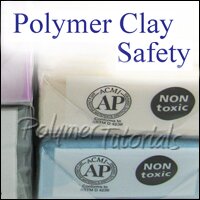Polymer Clay Safety
| All polymer clays on the US market have been evaluated by The Art and Creative Materials Institute, Inc. (ACMI) and found to be non-toxic. They bear ACMI's AP Seal (located on each package of polymer clay). This means that these materials were certified in a toxicological evaluation that they do not contain any compounds in sufficient quantities to be toxic or injurious to humans, including children, or to cause acute or chronic health problems. Also, it has been mandatory under federal law since 1990 that if any craft materials are not certified as non-toxic, they should bear a hazard label on their packaging. No polymer clays have such a label. |
 |
Phthalates
After restrictions on use of certain phthalates took effect in 2008 in the European Union and in the state of California, some polymer clays were reformulated to meet the new standards. Currently, all polymer clays on the US market comply with Consumer Products Safety Improvement Act of 2008 (CPSIA), which means that they do not contain more than 0.1% of any of the six phthalates restricted or banned by the regulations.
Prior to 2008, there were multiple safety studies conducted by various reputable groups, including the Toxicological Team at Duke University Medical Center and the Art and Creative Materials Institute (ACMI). These studies found that when polymer clays are used as intended and baked properly, they are not hazardous.
To be fair, I have to mention the 2002 (prior to the re-formulations) study by Vermont Public Interest Research Group, Inc., (VPIRG), in which polymer clay users were warned about possible exposure to significant amounts of phthalates. The results of this study were immediately challenged by ACMI, who published a press-release restating that their experts found polymer clay to be safe when used as directed.
Hydrochloride Gas
Hydrochloride gas in small quantities can be produced if a polymer clay item is burned. Please refer to my tutorial How to bake polymer clay items to learn how to correctly bake polymer clay.
Hydrochloride gas may be released when polymer clay is exposed to high temperatures (above 350F), causing the clay to darken. This gas may cause eye and nose irritation but it would not have any long-term effects. It has a very strong and distinct smell and is easily detected by humans in very small quantities. If you notice that your polymer clay is burning, turn off the oven and ventilate the room. To minimize your discomfort, leave the room until it has been completely aired out.
High Temperatures
Use your common sense and handle hot objects with proper care.
Sharp Objects
Stainless steel cutters and X-acto knives used for polymer clay are extremely sharp. One of the common injuries among novice clayers happens when people press on the wrong side of a stainless steel cutter by mistake while cutting through the clay. To avoid this problem, use stainless steel cutters with handles (commercial or hand-made). Another good idea is to clearly mark the safe, dull side of the cutters with some nail polish.
Small Particles, Dust
Polymer clay dust may be produced while sanding baked polymer clay. To prevent negative effects on your lungs and eyes, wear a dust mask and safety goggles during this procedure or use a wet-sanding technique.
Dyes
Make a habit of always working on a sheet of glass or ceramic tile, because dyes and plasticizers from raw clay may stain your furniture. Wash your hands after working with polymer clay (or wear nitrile gloves).
Polymer Clay and Food
It is not recommended to make polymer clay items that will be coming in contact with food. This is mostly because no sufficient information is available about this application. In other words, no studies were conducted to address possible safety concerns, so nobody can guarantee that no short- or long-term effects would be observed when someone eats out of polymer clay plate, for example.
Pretty much for the same reason, after any kitchen items and utensils had been used for working with polymer clay, they are not recommended to be used once again in food preparation.


